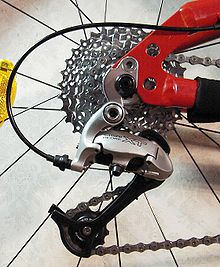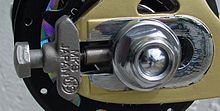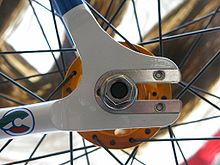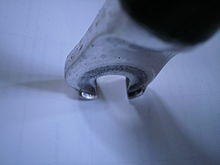- Dropout (bicycle part)
-
A semi-horizontal dropout on a steel frame road bicycle converted to a single-speed. The non-replaceable derailleur hanger (below the axle) and an eyelet (above the axle) for mounting a fender or rack are now unused.

 A vertical dropout on an aluminum frame mountain bike. The silver part is the replaceable derailleur hanger.
A vertical dropout on an aluminum frame mountain bike. The silver part is the replaceable derailleur hanger.
A bicycle dropout is a type of fork end[1] that allows the rear wheel to be removed without first derailing the chain. The more inclusive term fork end refers to a slot in a frame or fork where the axle of the wheel is attached.
On bicycles that do not have a derailleur or other chain tensioning device, rear horizontal dropouts allow adjustment of chain tension, and can accommodate a range of chain lengths or cog sizes. They were standard on most older derailleur bicycles from before the 1990s. An older derailleur-equipped bicycle with horizontal dropouts can be readily converted into singlespeed, fixed gear or to use an internally geared hub.
Track bicycles traditionally do not utilize dropouts, but instead have track fork ends, on which the opening faces rearwards. Because they do not have dropouts, the chain must be derailed from the cog before the rear wheel can be removed from a typical track bike. Some single-speed bicycles intended for street or trail use are also equipped with track fork ends instead of dropouts.
Rear vertical dropouts have the slot facing downwards. The advantage is that the wheel axle cannot slip forward compared with horizontal dropouts. The disadvantage is that on a bicycle without a rear derailleur but with vertical dropouts, the chain tension cannot be adjusted by moving the wheel forwards or backwards, and needs another means of chain-tensioning, by a derailleur, chain tensioner, or eccentric bottom bracket or rear hub. Fixed wheel bicycles cannot use any form of chain tensioning device, because the lower run of chain is pulled very tight when using the transmission as a brake.
In general, a modern bicycle frame intended for derailleur gears will have a vertical dropout, while one designed for singlespeed or hub gears will have horizontal dropouts or track fork ends.
Contents
Features
Derailleur hanger
The derailleur hanger or mech hanger is the part of the dropout that the rear derailleur attaches to.
Most non-steel framed bikes have a separate removable derailleur hanger, generally made from aluminium which is bolted to the dropout. These are intended as a cheap replaceable part so that in the event of an accident or mechanical problem that could damage the derailleur or frame, the derailleur hanger breaks or deforms instead. Sometimes a shear bolt which is designed as a weak point will also be used. There are dozens of different derailleur hangers available and one model is seldom interchangeable with another.
In general, steel-framed bikes do not have a removable derailleur hanger, because a steel dropout and hanger is stronger and therefore less likely to be damaged, and also it is more malleable and less likely to work harden during deformation and generally can be bent back into shape without breaking.
It is important for proper indexed shifting for the derailleur hanger to be properly aligned. The rear derailleur bolt hole must be close to parallel with the rear axle. If it is out of alignment, the rear derailleur will not move far enough, with respect to the rear sprockets, with each click. A special tool exists to measure and correct misaligned hangers.
On frames with no derailleur hanger, a direct mount derailleur or derailleur with a hanger plate is used. These only fit bikes with horizontal dropouts, and are held in place by a small bolt and the rear wheel axle. These have now been effectively superseded by the derailleur hanger. Since a derailleur designed to be fitted to a separate hanger will be aligned lower on the bike than one that bolts directly onto the frame, it follows that a derailleur must be selected firstly with the mounting method in mind.
Lawyer lips
Lawyer lips or lawyer tabs (a type of positive retention device) are tabs fitted to the fork ends on the front fork of bicycles sold in some countries (particularly the U.S.) to prevent a wheel from leaving the fork if the quick release skewer comes undone. They were introduced in response to lawsuits supported by experts including John Forester, in cases where incorrectly adjusted quick release wheels came out of the forks. Lawyer tabs are designed to compensate for the fact that many riders do not know how to operate a quick release properly: some riders treat them as a folding wing nut, and others do not tighten them enough for fear of snapping them or shearing the skewer (both are not likely given the normal range of human strength, and the mechanical advantages involved, as long as the skewer is not damaged or flawed).
A side-effect is that the quick release, which was developed to allow the wheel to be removed without having to unscrew any components, no longer works as designed: the skewer must be unscrewed in order to remove the wheel (although tools do remain unnecessary). This means that the tension on refitting must be adjusted again. Some cyclists file off the lawyer tabs so the quick release works as originally intended.
A correctly secured quick release is unlikely to be ejected from the dropout in normal use where rim brakes are in use, although recently there has been some evidence, notably from James Annan, a British scientist working in Japan, suggesting that the moments in disc brake systems can cause quick-release front wheels to be ejected past the lawyer tabs. A small number of serious crashes have been attributed to this cause. This is controversial, and the fork manufacturers have not admitted a fault, although there is some evidence that they may accept the principle, and advice on checking quick release tension has been strengthened.[2][3] A complete solution to ejection risk would involve mounting the front disc brake caliper in front of the fork blade rather than behind, as the reaction force on the disc would then be into, rather than out of, the fork-end. However, this would involve major retooling by fork and brake manufacturers, though at least one manufacturer has placed the disc caliper mounts on the front of the right fork blade. This allows standard brakes to be used, and also makes it easier to mount mudguards.[4]
Eyelets
Dropouts may support one or more eyelets, small protruding tabs with holes, often threaded, to facilitate the mounting of racks and fenders.
Adjustment screws
Some rear, horizontal, forward-facing dropouts have small adjustment screws threaded through the very rear to aid in positioning the axle precisely. The screws may be fitted with springs to keep them from moving.[5] The most common screw size for the adjustment screws is M3.[6]
Chaintugs
 Mikishima Chaintug on a Keirin bicycle
Mikishima Chaintug on a Keirin bicycle
Some rear track fork ends have threaded devices ("chaintugs") to aid in setting the proper chain tension. These may be integral to the fork end or separate items. They work by holding the rear axle in an eye at the end of a threaded bolt. The bolt passes through a cap which fits over the open track end. Tightening the bolts on each side causes the axle to be pulled backwards towards the open track end, tensioning the chain. Chaintugs can also solve the problem of "axle creep" on hard-ridden fixed-gear bicycles, especially those with hard chromed track ends, which may not offer adequate grip for the serrated track nuts.[7]
References
- ^ Brown, Sheldon. "Sheldon Brown's Glossary: Drop out". Sheldon Brown. http://www.sheldonbrown.com/gloss_dr-z.html. Retrieved 2008-01-06.
- ^ "Disk brakes and quick releases - what you need to know". http://www.ne.jp/asahi/julesandjames/home/disk_and_quick_release/index.html. Retrieved 2007-01-18.
- ^ "Technical Q&A with Lennard Zinn - Funky Disco Drop-out". Archived from the original on 2006-10-30. http://web.archive.org/web/20061030042233/http://www.velonews.com/tech/report/articles/5432.0.html. Retrieved 2007-01-18.
- ^ "Cotic: ROADHOG Forks Have Their Disc Mount on the Right : What's That All About?". http://www.cotic.co.uk/geek/. Retrieved 2009-11-26.
- ^ "DROPOUT ADJUSTING SCREW SETS WITH SPRINGS". http://www.novacycles.com/catalog/product_info.php?products_id=80. Retrieved 2007-01-18.
- ^ "Dropout adjustment screws". http://www.bikeforums.net/archive/index.php/t-274077.html. Retrieved 2009-11-16.
- ^ "Surly Tuggnuts". http://www.63xc.com/rickc/tuggnuts.htm. Retrieved 2007-01-18.
External links
List of bicycle parts Frame Handlebars · Stem · Head tube · Headset · Fork · Seatpost · Saddle · Bottom bracket · Dropout · Suspension
Wheels Drivetrain Cabling Peripherals Basket · Bell · Bottle cage · Fairing · Cyclocomputer · Kickstand · Lighting · Luggage carrier · Mudguards · Pannier · Saddlebag · Reflectors · Skirt guard · Training wheelsCategories:- Bicycle parts
Wikimedia Foundation. 2010.



